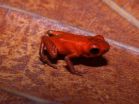(Press-News.org) Rolapitant reduces nausea and vomiting in patients receiving cisplatin-based chemotherapy, according to the results of a phase III trial presented for the first time today at the ESMO 2014 Congress in Madrid, Spain.
Dr Martin Chasen, lead author and medical director, Palliative Care, Ottawa Hospital Cancer Centre, Canada, said: "This agent makes a significant difference in the way people tolerate their chemotherapy. Patients experienced no loss in quality of life and, in fact, many saw meaningful improvements. One of the patients in the rolapitant cohort reported that he had just finished 18 holes of golf one week after receiving chemotherapy. This is in sharp contrast to many patients on current standard anti-emetics that are too ill to get out of bed within a week after each cycle of cisplatin."
"We must treat nausea and vomiting, not just the cancer," added Chasen, emphasising that some patients are extremely sensitive to cisplatin effects and recalling that he had one or two patients with curable cancers who refused treatment after one round of cisplatin. "They preferred to die," he said.
The phase III trial investigated rolapitant, a novel antagonist of the NK-1 receptor, for the prevention of severe nausea and vomiting often experienced by patients receiving cisplatin-based chemotherapy, which may cause dose reductions and treatment discontinuation. The multicentre trial randomised 532 patients 1:1 to receive rolapitant plus granisetron/dexamethasone or placebo plus granisetron/dexamethasone prior to cisplatin-based chemotherapy.
The primary endpoint was complete response (defined as the patient having no emesis and not requiring any rescue medication) in the delayed phase (>24-120 hours) post-chemotherapy. Key secondary endpoints included complete response during the acute (0-24 hours) and overall (0-120 hours) phases.
The trial met its primary endpoint, with 72.7% of patients receiving rolapitant achieving complete response in the delayed phase compared to 58.4% of those receiving placebo (p END
Rolapitant reduces nausea and vomiting in Phase III trial
2014-09-27
ELSE PRESS RELEASES FROM THIS DATE:
Countries must work together to stop organ traffickers, says researcher
2014-09-27
The author of new research into organ trafficking has called for a concerted international effort to confront the problem.
Dr Ana Manzano, of the School of Sociology and Social Policy at the University of Leeds, says a combination of factors means nobody knows definitively how many organs are being traded across the world.
She said: "Unless these issues are addressed and countries work together to take firm action against the traffickers, more people who have their organs trafficked will die.
"Even in the UK, although the World Health Organization has identified us ...
Smoke still rising from King Fire in California
2014-09-26
Over 96,004 acres have been burned by the King Fire since it began on September 13, 2014. The fire is currently 68% contained, and the cause of the fire is arson. Just a few days ago, (Sept. 23) the fire was only 38% contained so progress on extinguishing it continues. Over 7,700 personnel are battling this fire.
A Pacific system came through the fire area yesterday (9/25) bringing 0.6-0.9 inches of rain. The observed fire activity was minimal with smoldering in interior pockets of the heavier fuels. A low pressure system will become the dominate feature today (9/26) ...
Agricultural fires blaze in Borneo
2014-09-26
The skies over Indonesian Borneo were filled with the smoke from hundreds of fires set deliberately to clear farmland. A shroud of thick, gray smoke hung over the area when the Aqua satellite captured this image on September 25, 2014. The Moderate Resolution Imaging Spectroradiometer (MODIS) instrument aboard the Aqua satellite detected dozens of fires (locations outlined in red) across the entire region from Central Borneo to South Borneo and even on East Laut Island.
Widespread burning in lowland forests on Borneo is an annual, manmade occurrence. People use fires ...
New molecule found in space connotes life origins
2014-09-26
Hunting from a distance of 27,000 light years, astronomers have discovered an unusual carbon-based molecule – one with a branched structure – contained within a giant gas cloud in interstellar space. Like finding a molecular needle in a cosmic haystack, astronomers have detected radio waves emitted by isopropyl cyanide. The discovery suggests that the complex molecules needed for life may have their origins in interstellar space.
Using the Atacama Large Millimeter/submillimeter Array, known as the ALMA Observatory, a group of radio telescopes funded partially through ...
Scientists discover new poison dart frog species in Donoso, Panama
2014-09-26
A bright orange poison dart frog with a unique call was discovered in Donoso, Panama, and described by researchers from the Smithsonian Tropical Research Institute and the Universidad Autónoma de Chiriquí in Panama, and the Universidad de los Andes in Colombia. In the species description published this week in Zootaxa, it was named Andinobates geminisae for Geminis Vargas, "the beloved wife of [coauthor] Marcos Ponce, for her unconditional support of his studies of Panamanian herpetology."
Every new species name is based on a representative specimen. The specimen for ...
Many patients excluded from clinical trials due to prior cancer, UTSW study finds
2014-09-26
DALLAS – Sept. 26, 2014 – Lung cancer clinical trials exclude a substantial proportion of patients due to a history of prior cancer, as shown in an analysis by cancer researchers at UT Southwestern Medical Center.
Among more than 50 lung cancer clinical trials examined, more than 80 percent excluded patients with prior cancer from participating, according to the study published in the Journal of the National Cancer Institute. The exclusion criterion was even applied in more than two-thirds of trials in which survival was not the primary endpoint.
"Our research demonstrates ...
Preference for built-up habitats could explain rapid spread of the tree bumblebee in UK
2014-09-26
The strikingly rapid spread of the Tree Bumblebee in Britain could be occurring because the bees readily live alongside humans in towns and villages – according to research from the University of East Anglia.
A new study published today shows that Tree Bumblebees are associated with built-up areas and that these areas form a large part of their habitat use.
These markedly different habitat and foraging preferences set this species apart from other common British bumblebee species – which could explain how Tree Bumblebees have managed to colonise much of the UK while ...
Policies of NIH, other funders, have improved data-sharing by life-science investigators
2014-09-26
Policies put into place by major funding agencies like the National Institutes of Health (NIH), and to a lesser extent by scientific journals, appear to be meeting the goal of increasing the sharing of scientific resources among life science investigators. As reported in the open-access journal PLOS ONE, 65 percent of surveyed investigators at major U.S. research institutions believed that NIH policies instituted in recent years had markedly improved the sharing of scientific data. But the survey also identified some unexpected problems, including the number of researchers ...
The scarring effects of primary-grade retention?
2014-09-26
An article released by Social Forces titled, "The Scarring Effects of Primary-Grade Retention? A Study of Cumulative Advantage in the Educational Career" by Megan Andrew explores the effect of scarring in the educational career in the case of primary-grade retention. Just as is the case for labor-market careers, events early in the educational career can leave lasting scars. Through the study, Andrew finds that primary-grade retention has lasting effects on educational attainments well after a student is initially retained: Retaining a child in early primary school reduces ...
Smelly discovery challenges effectiveness of antimicrobial textiles
2014-09-26
Anti-odour clothing may not be living up to its promise, and an ALES researcher is saying it
could all be a matter of how the product was tested.
In two separate experiments, Human Ecology researcher Rachel McQueen and her team found that some antimicrobial textiles were far more effective at performing their advertised tasks in the lab than in testing on humans. In one experiment, the fabrics were designed to help lower the risk of infection; in the second, the fabric was treated with a silver compound, which can be marketed preventing odour in clothing.
"We aren't ...




